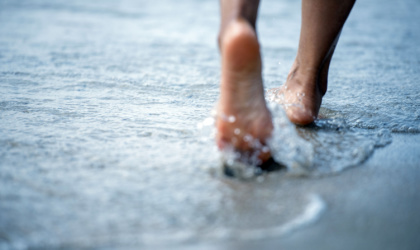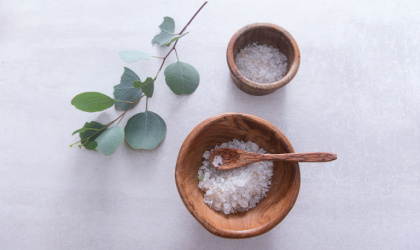
If you live with physical discomfort, it can be tempting to circumvent movement altogether to avoid further injury. But the opposite is, in fact, true. Activity turns down the physical discomfort ‘volume button’. Inactivity, by contrast, can trigger a cascade of events known to exacerbate symptoms. Here, we look at the role movement plays in ongoing physical discomfort.
What is persistent physical discomfort?
Most injuries heal within 2-3 months. Beyond that window, the original physical discomfort signal may have become a learned response in the brain and nervous system. The part of the brain that activates this learned response is also connected to fear, memory, and emotions. Once it’s learned, this signal can be activated by physical activity-based triggers, like fear of movement, or psychological triggers, like a stressful situation or challenging emotion. And that’s how discomfort can become persistent for some people.
How does movement help manage ongoing physical discomfort?
Movement is a form of rehabilitation
Although ongoing discomfort can trick you into thinking you need bed rest – especially since many doctors used to prescribe this – movement is one of the best forms of rehabilitation. Exercise stretches stiff muscles and ligaments. It can also prevent muscular atrophy, which reduces physical discomfort by improving flexibility and strengthening muscles.
Movement can reduce fear
When you experience ongoing discomfort, your brain is often overwhelmed with messages of danger, hopelessness, and fear. And these negative emotions can be connected to movement. If you have discomfort in your lower back, for example, walking may become a trigger. Your brain might convince you that walking will make your back worse. But this thinking pattern will only keep the cycle of physical discomfort going.
Gradually increasing movement is one of the best ways to re-educate an overprotective brain. Gentle exercise reminds your body that moving is safe and there’s nothing to be feared. If you walk around the block and it goes well, you’ll probably have less fear afterwards. That’s a corrective experience. Once you've collected enough corrective experiences, your brain learns that whatever it was afraid of isn’t dangerous, and your discomfort may lessen.
Movement releases endorphins
Stress and low mood often go hand in hand with ongoing physical discomfort. Exercise releases feel-good hormones called endorphins, which generate feelings of wellbeing, positivity, and energy throughout the body (1). By elevating mood and reducing lethargy, movement may help manage symptoms of discomfort.
Movement regulates sleep patterns
Sleep is one of the first areas to go if you live with physical discomfort. And without adequate restoration, you’re more likely to feel anxious, low, and sensitive to discomfort, which can fuel symptoms. Movement prepares your body for sleep, helping you fall asleep quicker and improving sleep quality, making it a great addition to your sleep routine (2).
Movement reduces sensitivity to discomfort
Inactivity tends to reinforce sensitivity to discomfort. Exercise, on the other hand, often reduces symptoms and raises people’s tolerance to uncomfortable sensations (3). For this reason, some studies suggest movement may eclipse those of other common treatments, like stress management and massage (4).
What type of exercise supports physical discomfort?
We’re not asking you to go from zero to a hundred. Gradually engaging in activities that involve moving more and sitting less will support your wellbeing and help manage symptoms. Build up slowly; start with light exercises, such as walking, gardening, swimming, yoga, or tai chi, and steadily increase the intensity.
If you’re worried about inducing a flare-up, that’s okay. Have a chat with a healthcare professional before you start exercising, which will help you find the right and safe approach.
When movement isn't possible
Some people are advised not to move, or to limit their movement, due to specific health conditions. When faced with this challenge speaking to a health professional is an advisable place to start, since they will be able to recommend the most appropriate exercises/movement for your unique physical needs.
Supplement support for physical discomfort
In addition to moving more, you may also wish to add the following supplements to your diet to manage symptoms.
Magnesium
Magnesium is an essential mineral that plays an integral role in many body processes. It is often recommended by nutritionists since it contributes to the maintenance of normal muscle function.
Vitamin D3
Vitamin D3 plays an important role in muscle and bone function, making it a popular choice.
PEA
PEA belongs to a group of natural compounds which are vital for chemical signalling in the body, and it can be found in almost every cell in the body. It is naturally produced when cells are damaged or threatened. It’s a popular choice to tackle those niggles that might hold you back.
Turmeric
Turmeric has a long history of use in health and wellness. Curcumin, the natural compound found in turmeric, is said to be responsible for the spice’s properties.
Glucosamine & Chondroitin
The combination of glucosamine and chondroitin has become one of the most popular supplements with millions of people choosing to take it on a regular basis.
Omega-3s
Found in oily fish and microalgae, the long-chain omega-3 fatty acids are important for good overall health. Omega-3s are often recommended as a perfect partner to Devil’s Claw.
Devil’s Claw
Devil's Claw is a traditional herbal medicinal product used for the relief of backache, rheumatic or muscular pain, and general aches and pains in the muscles and joints.
Rosehip
Regarded as a 'super-fruit' by herbalists, rosehip is a popular choice for those who take Glucosamine or Devil’s Claw.
Want to find out more?
Read more of our resources on managing physical discomfort here. You can also reach out to our expert Nutrition Advice team to receive free nutrition advice. No matter how small your query, they’re happy to help.
Call: 01892 352927
Email: nutrition@naturesbest.co.uk
Write: Nature’s Best Ltd. Century Place, Tunbridge Wells, Kent, TN2 3BE
References:
-
Available online: https://www.ncbi.nlm.nih.gov/pmc/articles/PMC1470658/
-
Available online: https://www.sleepfoundation.org/physical-activity/exercise-and-sleep
-
Available online: https://pubmed.ncbi.nlm.nih.gov/24504426/
-
Available online: https://www.sciencedirect.com/science/article/abs/pii/S014976342030645X?via%3Dihub
Related Posts

Olivia
Olivia Salter has always been an avid health nut. After graduating from the University of Bristol, she began working for a nutritional consultancy where she discovered her passion for all things wellness-related. There, she executed much of the company’s content marketing strategy and found her niche in health writing, publishing articles in Women’s Health, Mind Body Green, Thrive and Psychologies.
View More



